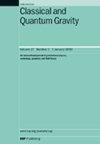从低熵假说看膨胀和暗物质以及修正引力的建模机制
IF 3.6
3区 物理与天体物理
Q2 ASTRONOMY & ASTROPHYSICS
引用次数: 0
摘要
宇宙初始状态熵低的假说通常解释了所观测到的熵增加只有一个时间方向:热力学时间箭头。广义相对论通常使用哈密顿形式主义。形式主义中引入了一组拉格朗日乘数,它们与哈密顿约束条件相对应,而哈密顿约束条件是以 "弱相等 "的形式写成的--如果约束条件成立,相等条件就满足。根据低熵假设,我们假定了一种建模机制--(建模的)弱等式,它只在某些建模约束所定义的物理模型理论空间的子空间上成立。通过应用建模机制,我们得到了在特定建模条件下的修正引力的特定模型。我们从建模机制中推导出一个新颖的建模方程,它描述了不同引力模型是如何出现的。如果普通物质可以忽略不计,建模方程的解自然就变成了 R2 重力模型(带有附加项)。我们还发现,这一机制导致了两种模型:大场膨胀和类波暗物质(DM)。有趣的是,波状暗物质模型得到了爱因斯坦环最新观测结果的支持。本文章由计算机程序翻译,如有差异,请以英文原文为准。
Inflation and dark matter from the low entropy hypothesis and modeling mechanism of modified gravity
The hypothesis of low entropy in the initial state of the Universe usually explains the observed entropy increase is in only one time direction: the thermodynamic arrow of time. The Hamiltonian formalism is commonly used in the context of general relativity. The set of Lagrange multipliers are introduced in the formalism, and they are corresponding to the Hamiltonian constraints which are written in terms of ‘weak equality’—the equality is satisfied if the constraints hold. Follow the low-entropy hypothesis, we postulate a modeling mechanism—a weak equality (of modeling) that holds only on the subspace of the theory space of physical models defined by some modeling constraints. By applying the modeling mechanism, we obtain a specific model of modified gravity under specific modeling conditions. We derive a novel equation of modeling from the mechanism, that describes how different gravitational models emerge. The solution of the modeling equation naturally turns out to be the model of R2-gravity (with additional terms) if ordinary matter is negligible. We also found that this mechanism leads to two models: large-field inflation and wave-like dark matter (DM). Interestingly, the wave-like DM model is supported by the most recent observations of Einstein rings.
求助全文
通过发布文献求助,成功后即可免费获取论文全文。
去求助
来源期刊

Classical and Quantum Gravity
物理-天文与天体物理
CiteScore
7.00
自引率
8.60%
发文量
301
审稿时长
2-4 weeks
期刊介绍:
Classical and Quantum Gravity is an established journal for physicists, mathematicians and cosmologists in the fields of gravitation and the theory of spacetime. The journal is now the acknowledged world leader in classical relativity and all areas of quantum gravity.
 求助内容:
求助内容: 应助结果提醒方式:
应助结果提醒方式:


